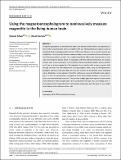Using the magnetoencephalogram to noninvasively measure magnetite in the living human brain
Author(s)
Khan, S; Cohen, D
DownloadPublished version (1.745Mb)
Publisher with Creative Commons License
Publisher with Creative Commons License
Creative Commons Attribution
Terms of use
Metadata
Show full item recordAbstract
© 2018 The Authors. Human Brain Mapping published by Wiley Periodicals, Inc. During the past several decades there has been much interest in the existence of magnetite particles in the human brain and their accumulation with age. These particles also appear to play an important role in neurodegenerative diseases of the brain. However, up to now the amount and distribution of these particles has been measured only in post-mortem brain tissue. Although in-vivo MRI measurements do show iron compounds generally, MRI cannot separate them according to their magnetic phases, which are associated with their chemical interactions. In contrast, we here offer a new noninvasive, in-vivo method which is selectively sensitive only to particles which can be strongly magnetized. We magnetize these particles with a strong magnetic field through the head, and then measure the resulting magnetic fields, using the dcMagnetoencephalogram (dcMEG). From these data, the mass and locations of the particles can be estimated, using a distributed inverse solution. To test the method, we measured 11 healthy male subjects (ages 19–89 year). Accumulation of magnetite, in the hippocampal formation or nearby structures, was observed in the older men. These in-vivo findings agree with reports of post-mortem measurements of their locations, and of their accumulation with age. Thus, our findings allow in-vivo measurement of magnetite in the human brain, and possibly open the door for new studies of neurodegenerative diseases of the brain.
Date issued
2019-04-01Department
Francis Bitter Magnet Laboratory (Massachusetts Institute of Technology)Journal
Human Brain Mapping
Publisher
Wiley
Citation
Khan, S and Cohen, D. 2019. "Using the magnetoencephalogram to noninvasively measure magnetite in the living human brain." Human Brain Mapping, 40 (5).
Version: Final published version